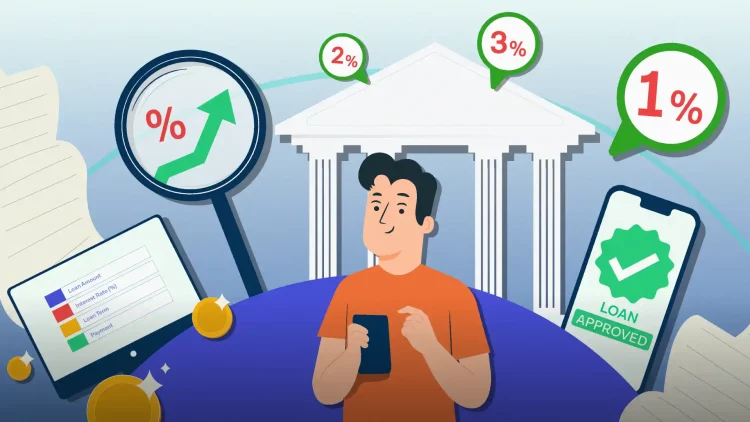Introduction: Recap of the Recent Interest Rate Hikes by the Federal Reserve
As we enter 2025, the global economy stands at a critical juncture. After years of historically low interest rates, the U.S. Federal Reserve has significantly raised rates to curb inflation, setting the stage for a crucial economic year. These interest rate hikes have been part of the Federal Reserve’s strategy to slow the economy and prevent inflation from spiraling further out of control. But with inflation still a concern and the effects of these rate hikes reverberating across various sectors, the question remains: will 2025 bring economic stability, or will it lead to setbacks?
In 2023, the Federal Reserve began raising its key interest rate, the Federal Funds Rate, in response to inflation that reached its highest levels in decades. By 2024, the Fed had implemented multiple rate hikes, bringing the benchmark interest rate to levels not seen since the early 2000s. These actions are part of a broader strategy to cool down the overheated economy, where soaring prices, driven by supply chain disruptions, energy costs, and pandemic-related fiscal policies, have caused real strain on both consumers and businesses.
As we look ahead to 2025, the question of whether these rate hikes will successfully bring inflation under control without derailing economic growth remains the focus of much debate. In this article, we will explore the effects of interest rate hikes, the ongoing concerns about inflation, market reactions, and predictions for 2025 and beyond. We will also examine how investors can adjust their portfolios to navigate the evolving economic landscape.
Inflation Concerns: How Inflation Is Affecting Consumer Spending and Business Investment
Inflation’s Persistent Grip
Inflation has been the primary economic concern for the past few years, driven by a combination of factors including supply chain disruptions, government stimulus programs, labor shortages, and surging demand for goods and services as economies reopened after the COVID-19 pandemic. In the U.S., inflation reached a peak of 9.1% in June 2022, marking the highest level in 40 years, and although it has since moderated, inflation remains stubbornly above the Federal Reserve’s 2% target.
For consumers, high inflation has resulted in increased prices for everyday goods, particularly in categories like food, housing, and transportation. The average cost of living has risen sharply, affecting household budgets and eroding purchasing power. As wages have not kept pace with rising prices, many American families have found themselves adjusting their spending habits, opting for lower-cost alternatives, and delaying discretionary purchases.
Impact on Consumer Spending
Consumer spending is a crucial driver of the U.S. economy, representing roughly 70% of GDP. When inflation remains elevated, consumers tend to become more cautious with their spending, prioritizing necessities and cutting back on luxury or non-essential items. This shift has resulted in a noticeable slowdown in sectors like retail, hospitality, and entertainment, as higher prices cause individuals to rethink their discretionary expenses.
Retail sales growth, for instance, has decelerated in the face of inflation, with consumers opting for store brands and discount retailers rather than premium products. Meanwhile, housing and automobile markets have also cooled, as rising mortgage rates, spurred by the Fed’s interest rate hikes, have made home ownership and car purchases less affordable for many Americans.
Business Investment and Inflationary Pressures
For businesses, high inflation is equally concerning, especially when combined with rising borrowing costs due to higher interest rates. Inflation increases the cost of inputs—raw materials, labor, and energy—which directly impacts profit margins. Companies, especially in manufacturing and construction sectors, have faced higher costs for everything from steel and lumber to shipping and transportation.
In addition to rising costs, businesses have been forced to adjust their pricing strategies, passing on some of the inflationary burden to consumers in the form of higher prices. While this has helped protect margins, it has also further contributed to inflation, creating a feedback loop of price increases. At the same time, uncertainty about the future economic environment has made business leaders wary of making significant new investments, leading to slower growth in capital expenditures.
Market Reactions: Wall Street’s Adaptation to Higher Interest Rates
The effects of the Federal Reserve’s interest rate hikes have reverberated across global financial markets. Wall Street has had to adjust to the new reality of higher borrowing costs, which has resulted in significant volatility in stock and bond markets. The initial shock of rising rates led to a major sell-off in equity markets, particularly in high-growth sectors like technology, which rely heavily on cheap capital to fuel expansion.
Stock Market Volatility
Tech stocks, in particular, experienced the brunt of the market correction in 2023 and 2024. Companies like Tesla, Amazon, and Meta Platforms saw their valuations shrink as investors recalibrated their expectations for future growth in a higher-rate environment. The growth-driven market that had been fueled by low interest rates and abundant liquidity gave way to a more cautious and risk-averse market.
Interest rate hikes make borrowing more expensive for businesses and individuals, which, in turn, dampens economic activity. For stocks, this means lower earnings growth potential, especially for companies in capital-intensive industries like tech, real estate, and biotechnology. As a result, investors turned more to value stocks—those that offer stability and reliable cash flows—as opposed to speculative growth stocks, which have higher valuations but carry more risk in a rising rate environment.
Bond Market Adjustments
The bond market also experienced significant turbulence in response to the Fed’s actions. As interest rates rise, bond prices fall, and yields increase. For fixed-income investors, this created a dilemma, as the value of their bond portfolios dropped. Long-duration bonds, in particular, saw the sharpest declines, as they are more sensitive to interest rate movements.
Higher yields, however, have created new opportunities for bond investors, particularly in short-term and inflation-protected securities. Treasury Inflation-Protected Securities (TIPS) and short-duration bonds have become attractive options for investors looking to protect themselves from rising inflation while maintaining more stable returns. In the corporate bond market, high-yield bonds, or “junk” bonds, have also been under pressure, as companies with weaker credit ratings struggle to refinance debt at higher rates.

Forecast: Predictions for 2025 and Beyond—Potential Economic Slowdown or Recovery?
As we move into 2025, the question remains whether the U.S. economy will stabilize or continue to face setbacks. The Federal Reserve’s policy actions in 2023 and 2024 have been aimed at curbing inflation, but the challenge remains: will these rate hikes bring inflation down to target levels without triggering a recession?
Inflation Outlook
While inflation has moderated somewhat from its peak in 2022, it remains above the Fed’s 2% target. A slowdown in consumer spending and business investment may help reduce price pressures, but factors such as rising wages, energy costs, and geopolitical events (such as the ongoing Russia-Ukraine war) could continue to keep inflation elevated.
In 2025, economists predict that inflation may continue to ease as supply chain disruptions resolve and global energy prices stabilize. However, the path to 2% inflation could be bumpy, and some sectors may continue to experience inflationary pressures. The Fed’s stance on interest rates will be a key factor in determining whether inflation remains under control or if new challenges arise.
Economic Growth and Recession Risks
The risk of a recession in 2025 remains a key concern. Higher interest rates typically lead to slower economic growth, and there are signs that the U.S. economy is already cooling. Consumer confidence has taken a hit, and the housing market has shown signs of weakening. Additionally, corporate earnings growth is expected to slow, as businesses face higher costs and reduced demand for goods and services.
However, the economy is not necessarily headed for a recession. Some analysts predict that a “soft landing” is possible, where inflation cools without causing widespread job losses or a significant economic contraction. The labor market, while showing signs of weakness, remains relatively strong, and continued growth in sectors like healthcare, energy, and infrastructure could help offset slowdowns in others.
Investor Strategies: How Should Investors Adjust Portfolios to Manage Risks?
In an environment of rising interest rates and ongoing inflation concerns, investors must be strategic in adjusting their portfolios to manage risk and seize opportunities. Here are some strategies to consider:
1. Focus on Inflation-Protected Assets
To hedge against inflation, investors should consider assets that tend to perform well in inflationary environments. Treasury Inflation-Protected Securities (TIPS) are an attractive option, as they provide a return above inflation. Real estate, particularly commercial real estate, is another asset class that historically performs well during periods of rising prices.
2. Embrace Value Stocks Over Growth Stocks
With higher interest rates, growth stocks, particularly in the tech sector, may struggle to maintain their valuations. Investors should consider shifting their portfolios toward value stocks, which tend to offer stable earnings and dividends. Sectors like utilities, consumer staples, and healthcare often perform better in environments of rising rates and slower growth.
3. Diversify with International Assets
Given the global nature of inflation and interest rates, diversifying into international markets can provide a buffer against domestic volatility. Emerging markets, in particular, may offer growth opportunities, as many of these economies are growing at faster rates than the developed world. However, geopolitical risks must be carefully considered.
4. Consider Short-Term Bonds and Floating Rate Notes
As interest rates rise, long-term bond prices typically decline. To mitigate the risk of falling bond prices, investors should focus on short-term bonds, which are less sensitive to interest rate changes.
Floating rate notes (FRNs), which have interest rates that adjust with market conditions, can also provide a good way to hedge against rising rates.
5. Keep Cash Reserves for Flexibility
With the possibility of market volatility, it is essential for investors to maintain liquidity in their portfolios. Holding a portion of the portfolio in cash or cash-equivalents provides the flexibility to take advantage of opportunities when they arise, whether in equities, bonds, or alternative investments.






























